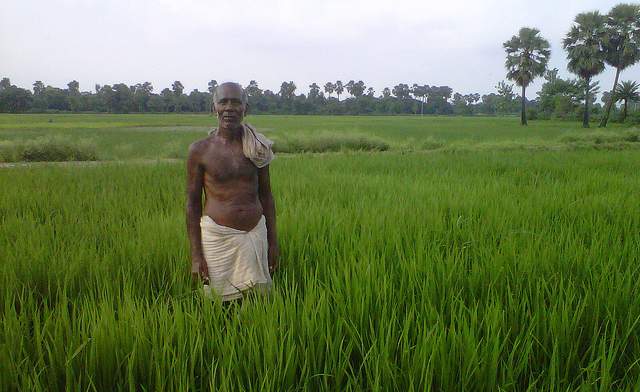Direct-seeded rice (DSR) can significantly reduce the amount of water needed to grow the crop. According to the Indian Agricultural Research Institute, the yields can be comparable with traditional transplanting methods as long as the plants are properly managed. DSR water savings can be up to 60 percent compared to traditional methods since DSR eliminates the need for water for sowing seeds in a nursery and greatly reduces the amount of water needed in the rice field.
Instead of the traditional transplanting of young rice plants from nurseries to flooded fields, the seeds are sown directly in much drier fields. The fields are maintained at a much drier level throughout the season compared to traditional methods. The planting is sometimes done by machine, though more often by hand, especially in the developing world. Direct sowing can reduce labor demands necessitated by transplanting by up to 40 percent. In addition, the elimination of transplanting can increase yield levels in some cases because of the fact that the young plants don’t experience transplant shock.
DSR can be especially valuable in developing countries, where 80-90 percent of fresh water is used for agriculture and a significant portion of that, especially in Asia, is used for rice. Various versions of DSR were actually a relatively common practice before the Green Revolution in countries like India, and they are now reemerging due to the advantages they can have for saving on water and labor inputs.
According to the Indian Agricultural Research Institute, there are a number of reasons that DSR can be a viable alternative to traditional rice-growing methods. First, high water demands can be difficult to meet when there is not a reliable water source on a seasonal basis. Flooded rice fields actually increase greenhouse gas emissions; for example, methane emissions increase in submerged anaerobic soil conditions. Direct seeding can reduce the disturbance of soil structure, as opposed to puddling, which is the tillage of paddies while they are flooded. In terms of labor, there is always the risk that there is not enough available labor during transplanting time. However, DSR reduces this extra step and thus eliminates the risk that the necessary labor is not available.
But according to Columbia University’s Earth Institute blog, farmers may be hesitant to practice a method that is so entirely new and different from traditional methods. In addition, the lack of flooded fields makes it easier for weeds to grow and compete with the rice plants for nutrients, sunlight, and moisture. Some farmers are addressing this challenge by using herbicides to suppress weed growth. However, this has its own problems given the risks that chemicals from the herbicides leach into the water supply. However, according to SS Johl, an Indian agricultural expert, in order to reduce or completely avoid the use of herbicides, the labor saved on transplanting can be transferred to hand-wedding.
In the developing world, there have been many experiments comparing DSR to traditional methods. Looking across the spectrum of these experiments, the Indian Agricultural Research Institute points out that “yields from DSR are broadly comparable with transplanted rice provided that weed management is effective.” Likewise, multiple studies in India have indicated that if weeds are not properly managed, DSR yields will likely be just a small fraction of yields from traditionally planted rice. Managed properly, DSR is an agricultural innovation that bears great potential to help rice farmers maintain their yields while doing their part to save water.
Sign up for Food Tank’s FREE Weekly Newsletter. More than 110,000 Subscribers And Counting. Click HERE to join.













